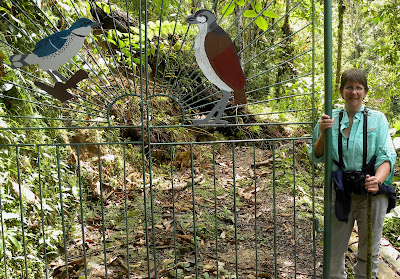 |
| Releasing a recently banded Ruby-throated Hummingbird. |
I drove to Battle Creek, Michigan today to watch members of the Great Lakes Hummernet Project band Ruby-throated Hummingbirds (RTHU). This is my second time to observe a banding operation. The highlight of my day was holding a RTHU in my hand and listening to the heartbeat (about 250 times per minute while resting) as I held it near my ear! The more I talk with people who are collecting data about hummingbirds in the U.S. the more I realize that there are many unanswered questions about these tiny creatures.
 |
| Measuring wing length of a captured RTHU |
· Spring arrival dates throughout Michigan
· Fall departure dates throughout Michigan
· Peak dates and numbers of hummingbirds during migration
· Migration routes and concentration points in Michigan
· Routes and timing of migration from Michigan to their wintering grounds
 |
| The elaborate Guillotine trap closes by remote control. |
 |
| The simple Dawkins Trap lures hummingbirds in with a bright red object. |
Our host in Battle Creek was Mary Bird. Her yard boasts 12 hummingbird feeders and many great nectar plants. Her feeders were taken down and 4 traps were set. Three Dawkins traps (DT) and one Guillotine trap (GT). The Guillotine trap had an impressive trap door operated by a remote control. These are expensive to make and didn’t seem to do as well today as the simple, inexpensive Dawkins traps. The DT was made from two peony stands sewn to pond mesh – simple and effective.
 |
| Rich reaches for a RTHU in the Dawkins Trap. |
 |
| Young male in the hand. The measuring and banding moves swiftly so that the birds are not stressed. |
 |
| An immature male of interest because he already has a pretty large red gorget. |
Today, I was able to see how much bigger the females are compared to the males (15-20% larger). Even their legs are obviously thicker (if a hummingbird leg can be called thick) than the males. The early spring banding I observed was catching only adult birds since nesting had not yet occurred – but in July there are also immature birds to be caught.
 |
| The bird is held in a pantyhose toe while the band is fastened. |
 |
| Hummingbird Paint |
 |
| Band is placed on a recaptured male that had lost his band. |
If they are a “recapture” this is recorded and the birds are marked with a dot of bright blue paint. This non-toxic temporary paint dot helps the citizen scientists to make observations about how far these birds are traveling and how often they are visiting food sources in their territories. All this data is then filed with the Bird Banding Laboratory. For a great explaination of the banding procedure visit the Great Lakes Hummernet page and help them with their research by submitting your observations:
Often female hummingbirds will have 2 broods each year -- one in May/June and the other in late July. Today, the banders were also looking for a brood patch – which was a new concept for me. The feathers on birds insulate their bodies - keeping in warmth. But, a mother bird needs to share her body warmth to incubate her eggs.
 |
| Using a straw to blow back the feathers and investigate the brood patch. |
When I started reading about hummingbirds I thought that because the Ruby-throated Hummingbird was so popular with the general public and because they were so comfortable with humans – that the science of these hummingbirds would be a done deal. This is just not the case. There are many questions to be answered about their migration and ecology and banding is one of the most important tools in ornithological research we have to address these questions. Less than 200,000 hummingbirds have been banded in the U.S. and Canada since banding hummingbirds began in 1954. We really have lots more work to do to understand the life of these miniature marvels of migration.
 |
| Tiny bands, carefully formed, are stored on a safety pin at this banding station. |














































